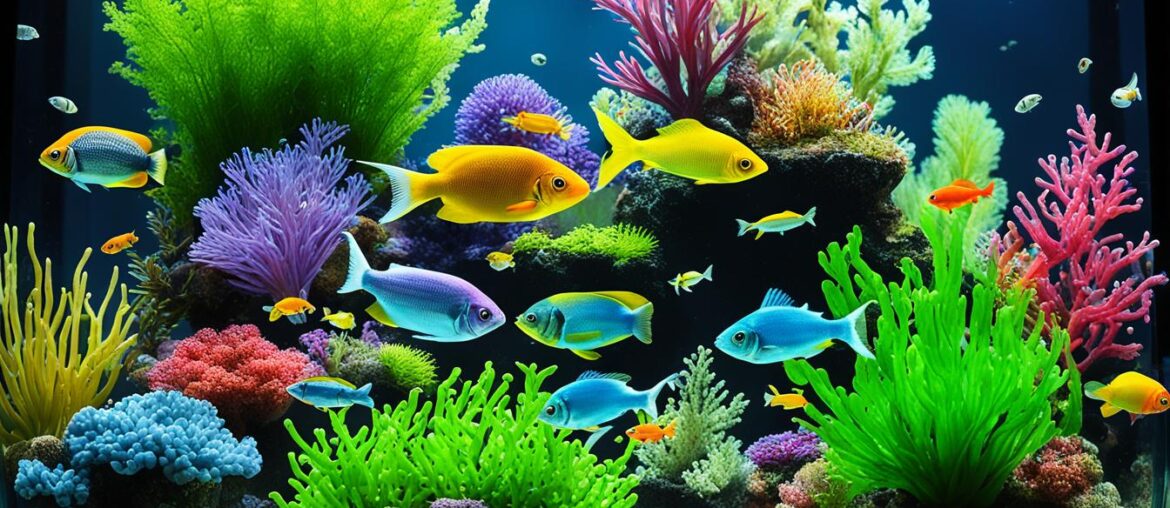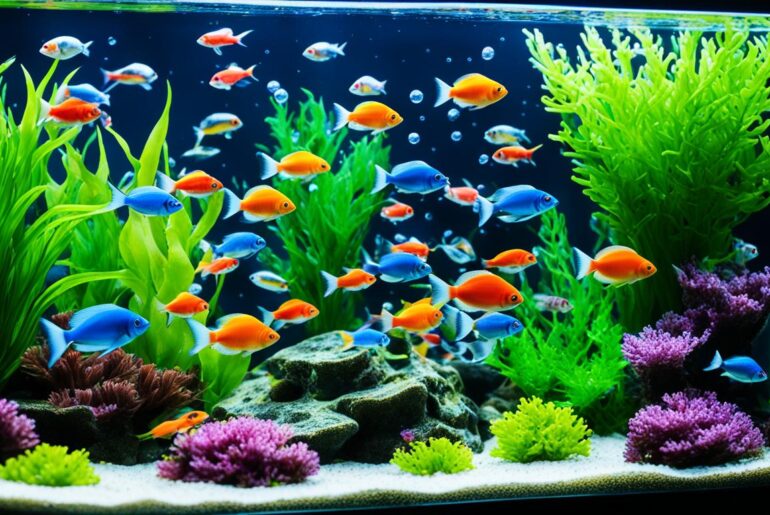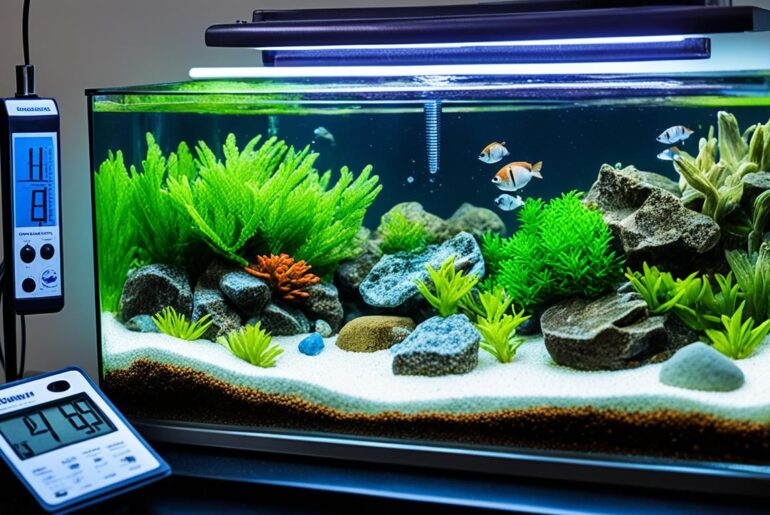As an avid aquarium enthusiast, I vividly remember the excitement and anticipation I felt when setting up my very first fish tank. I carefully selected the perfect aquarium, added vibrant decorations, and filled it with crystal-clear water. But little did I know that creating a thriving aquatic ecosystem involved much more than just aesthetic choices.
I soon discovered the importance of establishing a healthy bacterial colony during the cycling process. It was a journey of trial and error, marked by the loss of a few fish and plenty of frustration. But through perseverance and a deep dive into the world of aquarium science, I unlocked the secret to creating a balanced and thriving aquarium environment.
Now, I want to share my knowledge and experiences with you, so you can embark on your own successful aquarium journey. In this essential bacteria guide for cycling new aquariums, we will explore the crucial role of bacteria in the nitrogen cycle, different cycling methods, and tips for maintaining a stable aquatic environment.
Whether you’re a beginner or an experienced fish keeper, understanding the essentials of aquarium bacteria will empower you to provide a safe and healthy home for your aquatic pets.
The Aquarium Nitrogen Cycle Explained
The aquarium nitrogen cycle is a natural process that plays a crucial role in maintaining a healthy and balanced aquatic environment for your fish. This cycle involves the conversion and consumption of nitrogen compounds, such as ammonia and nitrite, by bacteria and plants in the aquarium. By understanding and facilitating the nitrogen cycle, you can ensure optimal water conditions and the well-being of your aquatic pets.
The nitrogen cycle starts with the introduction of ammonia into the aquarium, either through fish waste or decaying organic matter. Nitrosomonas bacteria convert ammonia into nitrite, a toxic substance for fish. However, nitrite is then further broken down by another type of bacteria called Nitrobacter into nitrate, which is less harmful to fish at lower levels.
The conversion of ammonia to nitrate is a vital process in maintaining a safe living environment for your fish. Excessive levels of ammonia and nitrite can be detrimental to the health of your fish, causing stress, diseases, and even death. By establishing a healthy bacterial colony, you can effectively remove ammonia and nitrite from the water, ensuring the well-being of your fish.
Plants in the aquarium also play a significant role in the nitrogen cycle. They not only consume nitrate as a nutrient but also produce oxygen, creating an optimal environment for beneficial bacteria to thrive. Through this symbiotic relationship between plants and bacteria, the nitrogen cycle is enhanced, promoting a stable and balanced ecosystem for your fish.
The nitrogen cycle is essential for successful aquarium cycling and maintaining optimal water conditions for your aquatic pets. Understanding this process is crucial for ensuring the health and well-being of your fish.
| Nitrogen Compound | Converts Ammonia to | Converts Nitrite to |
|---|---|---|
| Ammonia | Nitrite | Nitrate |
| Conversion Bacteria | Nitrosomonas | Nitrobacter |
Fish-In Cycling: A Common Approach
Fish-In cycling is a popular method used by both beginner and experienced fish keepers to establish a healthy nitrogen cycle in their aquariums. In this approach, a few hardy fish are added to the new aquarium to kickstart the cycling process. These fish produce waste, primarily ammonia, which serves as a food source for beneficial bacteria.
When implementing Fish-In cycling, it is crucial to start with a small number of fish to prevent overwhelming the system. Gradually increasing the amount of food given to the fish helps maintain a steady production of ammonia, ensuring that the bacteria have enough waste to consume.
To ensure the success of Fish-In cycling, regular water testing is essential. Monitoring ammonia, nitrite, and nitrate levels allows you to gauge the progress of the nitrogen cycle and make adjustments as needed. Partial water changes should also be performed to maintain a safe and stable environment for the fish.
“Fish-In cycling is a popular and effective method for kickstarting the nitrogen cycle in a new aquarium. By carefully introducing a small number of fish and providing them with a controlled amount of food, you can help establish a balanced ecosystem for your aquatic pets.” – Emily, experienced aquarist
Benefits of Fish-In Cycling:
- Accelerates the establishment of beneficial bacteria in the aquarium
- Mimics a more natural cycling process by utilizing the waste produced by fish
- Allows for the observation and monitoring of fish behavior during the cycling process
- Fosters a balanced ecosystem that can support a greater variety of fish and plants
Fish-In Cycling Tips:
- Start with a small number of hardy fish species, such as zebrafish or guppies, to reduce the risk of ammonia spikes
- Gradually increase the amount of food given to the fish to ensure a steady supply of waste for the bacteria
- Regularly test the water parameters to monitor the progress of the nitrogen cycle
- Perform partial water changes as needed to maintain a safe and stable environment
By following these tips and closely monitoring the water conditions, Fish-In cycling can be a highly effective method for establishing a healthy and thriving aquarium ecosystem.
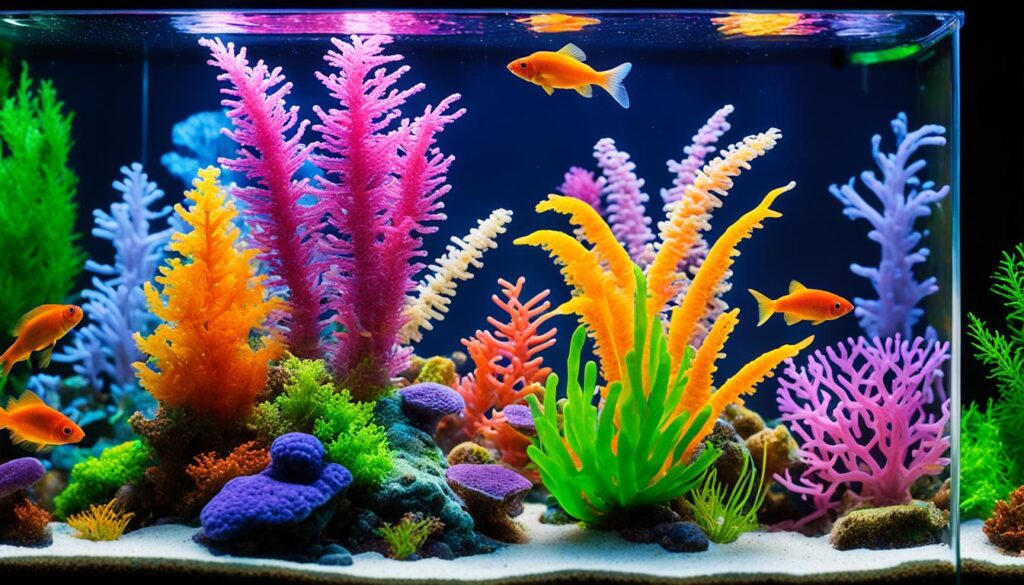
| Pros | Cons |
|---|---|
| Accelerates the establishment of beneficial bacteria | Potential stress and health risks for fish due to elevated ammonia levels |
| Mimics a more natural cycling process | Requires careful monitoring and adjustments to prevent ammonia spikes |
| Allows observation and monitoring of fish behavior | May limit the choice of fish species during the cycling process |
| Fosters a balanced and diverse ecosystem | Can take longer to establish a stable cycle compared to fish-less methods |
Cycling with Plants: Creating a Natural Ecosystem
When it comes to creating a natural and visually appealing aquarium ecosystem, cycling with plants is the way to go. Live aquarium plants not only enhance the aesthetic appeal of your tank but also play a crucial role in maintaining water quality and promoting the growth of healthy bacteria. By establishing a planted tank, you can create a sustainable and vibrant aquatic environment for your fish to thrive in.
One of the key advantages of cycling with plants is their ability to consume nitrogen waste more effectively. In the nitrogen cycle, beneficial bacteria convert ammonia into nitrite and then nitrite into nitrate. However, live plants also contribute to this process by using these compounds as a source of nutrients for their growth. By actively absorbing ammonia and nitrate, plants help maintain balanced water conditions and reduce the risk of harmful levels of these compounds.
Additionally, live plants create a natural habitat for beneficial bacteria in the aquarium. The roots, leaves, and surfaces of the plants provide a substrate for the growth of these bacteria, enhancing their colonization and effectiveness. The presence of plants in the tank also helps increase oxygen levels and reduce the accumulation of organic matter, further contributing to a healthier aquatic environment.
Benefits of Cycling with Plants:
- Improved water quality: Plants remove nitrogen waste and toxins, promoting a healthier ecosystem.
- Natural filtration: The roots of live plants act as a natural filtration system, removing impurities from the water.
- Oxygenation: Plants release oxygen during photosynthesis, ensuring a well-oxygenated environment for your fish.
- Enhanced aesthetics: Adding plants to your tank creates a visually appealing and natural-looking aquatic landscape.
Nothing compares to the beauty and vitality that live plants bring to an aquarium. Not only do they provide shelter, oxygenation, and natural filtration, but they also contribute to the overall health and well-being of your fish. Cycling with plants is truly an investment in the long-term success of your aquatic ecosystem.
If you’re considering cycling with plants, make sure to choose suitable species that are compatible with your fish and tank conditions. Opt for plants that are known for their ability to absorb nutrients and help maintain water balance. Research the specific light, temperature, and nutrient requirements of the plants you select to ensure they thrive in your aquarium environment.
By incorporating plants into your cycling process, you can establish a natural and self-sustaining ecosystem that benefits both your fish and the overall health of your aquarium. Cycling with plants is a rewarding experience that allows you to create a vibrant underwater world while maintaining optimal water quality for your aquatic pets.
Fish-Less Cycling: A More Humane Approach
Fish-less cycling provides a more humane method of establishing a healthy bacterial colony in your aquarium, without subjecting fish to high levels of ammonia. Instead of relying on live fish to produce ammonia, this approach introduces ammonia from alternative sources such as bottled ammonia, fish food, or decaying organic matter. By simulating the presence of ammonia without fish, you allow the essential nitrogen cycle bacteria to establish and grow, ensuring a stable and safe environment for your aquatic pets.
Regular water testing is crucial during the fish-less cycling process to monitor the levels of ammonia, nitrite, and nitrate. Maintaining the appropriate balance of these compounds is essential for the growth and health of the beneficial bacteria responsible for breaking down ammonia and converting it into less harmful substances. Monitoring the cycling progress ensures a successful establishment of the bacterial colony, setting the stage for a thriving and balanced aquatic ecosystem.

By adopting a fish-less cycling approach, you prioritize the well-being of your fish while still establishing the necessary nitrogen cycle bacteria. This method not only reduces the stress on fish but also minimizes the risk of exposing them to potentially harmful ammonia levels during the cycling process. Fish-less cycling is a more considerate and conscientious approach to setting up a healthy and sustainable aquatic system for your beloved aquatic pets.
The Role of Nitrifying Bacteria in Aquarium Cycling
When it comes to aquarium cycling, nitrifying bacteria play a crucial role in maintaining a healthy and balanced ecosystem for your fish. These beneficial bacteria, specifically Nitrosomonas spp. and Nitrobacter spp., are responsible for converting harmful ammonia and nitrite into less toxic nitrate.
Nitrosomonas spp. are the primary nitrosifying bacteria that convert ammonia into nitrite through a process called nitrification. This conversion is an essential step in the nitrogen cycle, as ammonia is highly toxic to fish in high concentrations. Nitrobacter spp., on the other hand, are responsible for the second step of nitrification, converting nitrite into nitrate.
These bacteria are naturally present in the air and will colonize any surface in the aquarium. However, they thrive in areas with high oxygen levels and a continuous supply of food, such as the filter and biomedia. Having a healthy population of nitrifying bacteria in the filter is crucial to efficiently process ammonia and nitrite, ensuring a safe and stable environment for your fish.
To encourage the growth of nitrifying bacteria, it’s important to provide them with the optimal conditions they need. You can achieve this by ensuring proper oxygenation and maintaining a consistent food supply, primarily through the introduction of ammonia. By keeping these bacteria thriving in your aquarium, you create a natural and self-sustaining system that promotes the long-term health of your fish.
Benefits of Nitrifying Bacteria in Aquariums:
- Conversion of toxic ammonia and nitrite into less harmful nitrate.
- Maintenance of a safe and stable environment for fish.
- Promotion of a balanced nitrogen cycle in the aquarium.
- Contribution to the overall health and well-being of fish and other aquatic organisms.
By understanding the critical role that nitrifying bacteria play in the aquarium cycling process, you can appreciate the significance of establishing and maintaining a healthy bacterial colony in your tank. These beneficial bacteria are essential partners in creating a thriving aquatic ecosystem for your fish to enjoy.
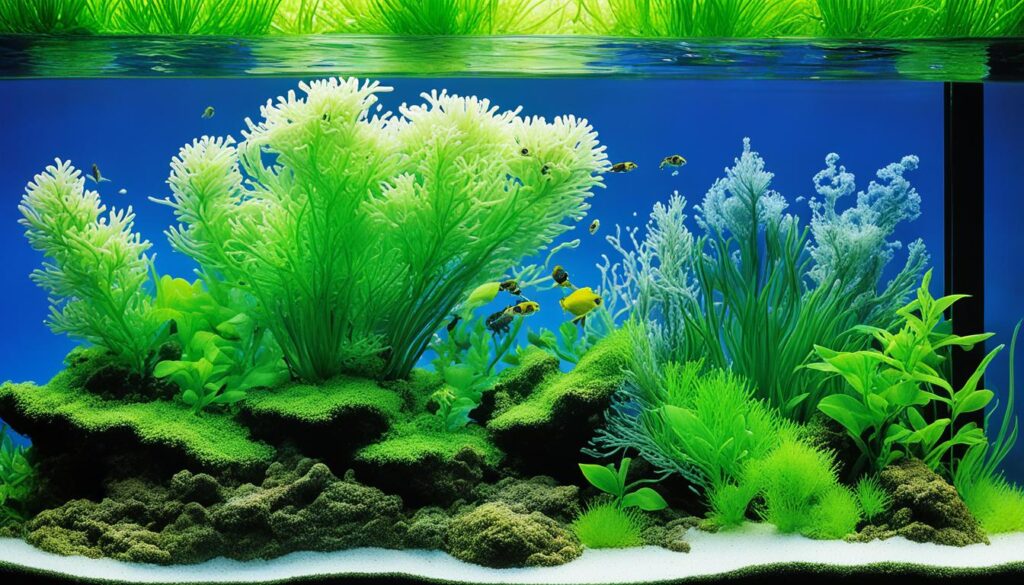
Factors Affecting Aquarium Cycling Time
The time required for aquarium cycling can vary depending on several factors. The size of the tank, water temperature, and pH levels can all influence how long the cycling process takes. Higher temperatures and a pH range of 7.0-7.8 are ideal for promoting the growth of nitrifying bacteria.
Regular water testing and monitoring of ammonia, nitrite, and nitrate levels are necessary to track the progress of the cycling process and ensure the tank is ready for fish.
Factors Affecting Aquarium Cycling Time
The time required for aquarium cycling can vary depending on several factors. The size of the tank, water temperature, and pH levels can all influence how long the cycling process takes. Higher temperatures and a pH range of 7.0-7.8 are ideal for promoting the growth of nitrifying bacteria. Regular water testing and monitoring of ammonia, nitrite, and nitrate levels are necessary to track the progress of the cycling process and ensure the tank is ready for fish.
“The size of the tank, water temperature, and pH levels all play a role in the duration of aquarium cycling. By providing optimal conditions for the growth of nitrifying bacteria, we can ensure a successful and efficient cycling process.”
To better understand how these factors impact aquarium cycling time, let’s take a closer look:
| Factors | Impact on Cycling Time |
|---|---|
| Tank Size | A larger tank generally takes longer to cycle due to the increased volume of water that needs to establish a stable bacterial colony. |
| Water Temperature | Higher temperatures accelerate bacterial growth and metabolic activity, reducing cycling time. However, extreme temperatures can stress the bacteria and slow down the process. |
| pH Levels | The growth of nitrifying bacteria is optimal within a slightly alkaline pH range of 7.0-7.8. Maintaining the appropriate pH levels can foster a faster cycling process. |
It is essential to regularly test and monitor the levels of ammonia, nitrite, and nitrate in the water during the cycling process. This helps ensure that the beneficial bacteria are effectively converting ammonia into less harmful substances, indicating that the tank is ready for fish.
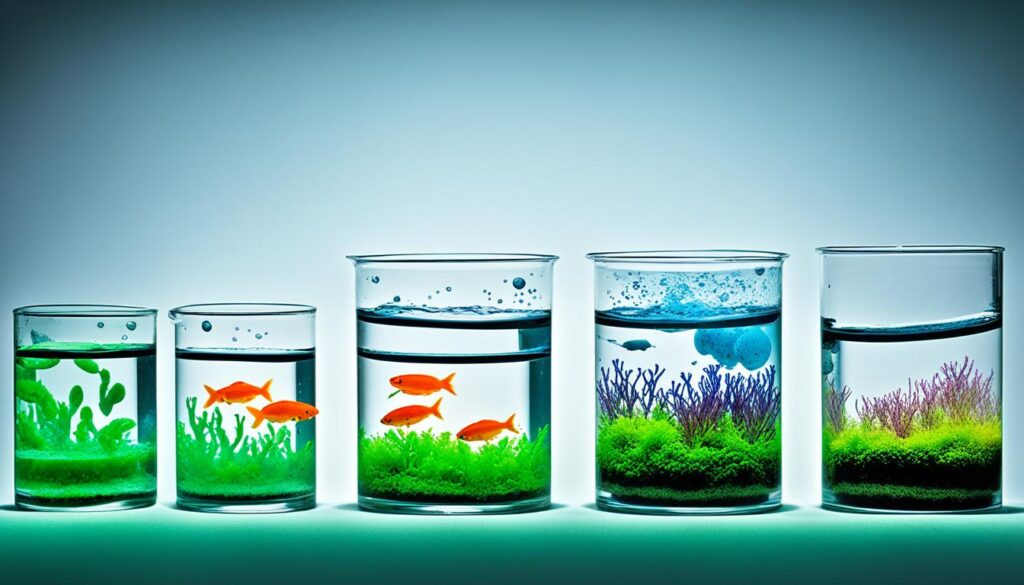
By understanding and managing these factors, we can optimize the aquarium cycling time and create a healthy environment for our aquatic friends.
Tips and Techniques for Successful Aquarium Cycling
To ensure successful aquarium cycling and maintain a healthy bacterial colony, there are several tips and techniques that you should keep in mind. Follow these guidelines to create an optimal environment for your aquatic pets:
- Gradually add fish: When cycling your aquarium, it is important to gradually introduce fish to prevent overwhelming the beneficial bacteria. Start with a small number of fish and allow the bacteria to adjust to the increasing bioload. This gradual approach promotes a stable and healthy bacterial colony, preventing water quality issues.
- Measure and maintain water quality: Regularly monitor water quality using ammonia and multi-test strips. These test kits allow you to measure ammonia, nitrite, and nitrate levels, ensuring that the cycling process is progressing as expected. By maintaining optimal water conditions, you create a favorable environment for the growth of healthy bacteria.
- Use live nitrifying bacteria supplements: Consider using live nitrifying bacteria supplements to speed up the cycling process. These supplements contain beneficial bacteria that help jumpstart the nitrogen cycle, reducing the cycling time. Select a reputable brand and follow the instructions provided for the best results.
- Stock the tank slowly: To maintain a stable environment, it is recommended to stock the tank slowly. Adding too many fish at once can stress the bacterial colony and lead to imbalances in the water parameters. By gradually introducing new fish, you give the bacteria time to adjust and maintain water quality.
- Perform regular water changes: Regular water changes are essential for maintaining optimal water conditions in the aquarium. They help remove accumulated waste, excess nutrients, and stabilize water parameters. Aim to perform weekly water changes of around 20% to promote a healthy and balanced ecosystem.
By following these tips and techniques, you can ensure a successful aquarium cycling process and establish a thriving aquatic environment for your fish. Remember to prioritize the health and well-being of your aquatic pets by maintaining healthy bacteria for aquariums and monitoring water quality regularly.
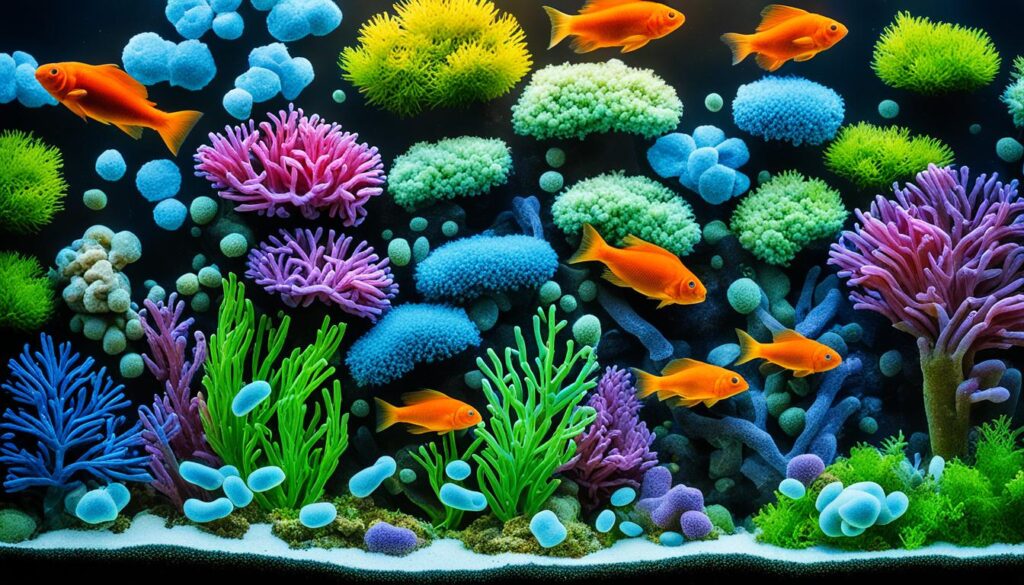
Maintaining a Stable Cycling Environment
Once your aquarium has completed the cycling process, it is important to maintain a stable environment for the fish. This includes regular monitoring of ammonia, nitrite, and nitrate levels, as well as performing routine water changes to keep the water parameters in check. Providing proper filtration, adequate oxygenation, and a balanced fish feeding schedule are essential factors in maintaining a healthy bacterial colony and a thriving ecosystem in the aquarium.
Regular monitoring of ammonia, nitrite, and nitrate levels helps ensure that the water conditions remain suitable for your fish. By testing the water regularly, you can catch any imbalances or potential issues early on and take appropriate action to rectify them. Monitoring kits, such as those that test for ammonia, nitrite, and nitrate, are readily available and easy to use.
Performing routine water changes is another crucial aspect of maintaining a stable cycling environment. Regular water changes help remove excess nutrients and waste products from the aquarium, promoting a clean and healthy aquatic ecosystem. Aim to change about 10-25% of the water every two weeks, or as needed based on your water testing results.
Proper filtration is essential in maintaining water quality and promoting the growth of beneficial bacteria. Choose a filtration system that is suitable for your tank size and stocked with appropriate filter media. The filter should provide mechanical, chemical, and biological filtration to remove debris, toxins, and establish a healthy bacterial colony.
Adequate oxygenation of the water is another crucial factor in maintaining stability in your aquarium. Oxygen is vital for both the fish and the beneficial bacteria. Ensure proper aeration in your tank by using air stones, surface agitation, or a dedicated air pump. This will help maintain optimal oxygen levels for the inhabitants of your aquarium.
Establishing a balanced fish feeding schedule is essential for both the health of the fish and the stability of the bacterial colony. Overfeeding can lead to excessive waste, which can cause a spike in ammonia levels. Feed your fish in small portions, only what they can consume within a few minutes. Avoid leaving uneaten food in the tank, as it can decompose and create ammonia spikes.
Tip: Regular maintenance practices, such as monitoring water parameters, performing water changes, maintaining filtration, and providing proper oxygenation, are essential for the long-term success of your aquarium’s cycling process.
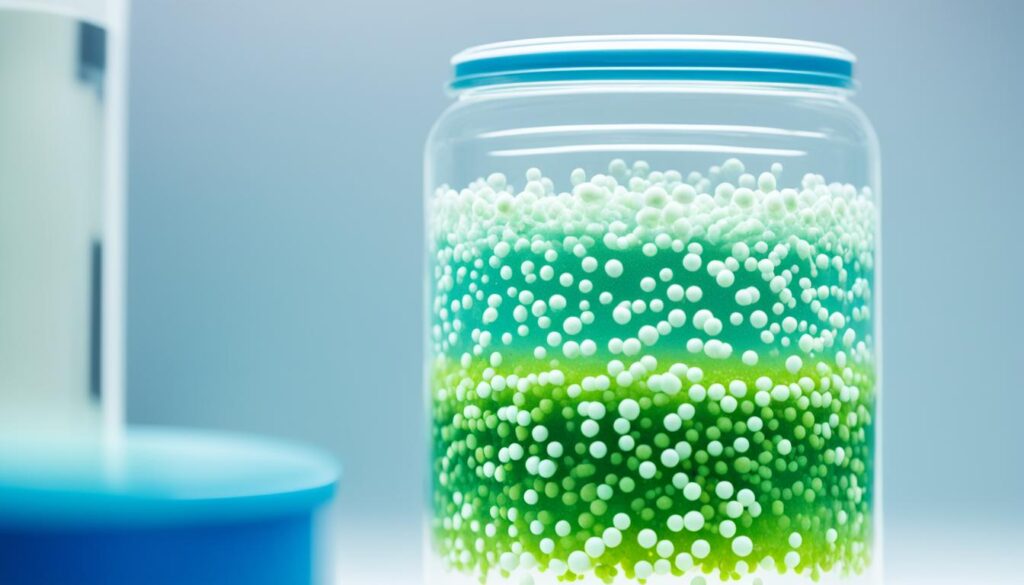
| Key Factors in Maintaining a Stable Cycling Environment | Actions to Take |
|---|---|
| Monitor Ammonia, Nitrite, and Nitrate Levels | Use water testing kits regularly to check the levels of these compounds and take appropriate action if needed. |
| Perform Routine Water Changes | Regularly change 10-25% of the water to remove excess nutrients and waste products. |
| Ensure Proper Filtration | Choose a suitable filtration system and maintain it with clean filter media to promote water clarity and bacterial growth. |
| Adequate Oxygenation | Use air stones, surface agitation, or an air pump to maintain optimal oxygen levels in the water. |
| Establish a Balanced Fish Feeding Schedule | Feed your fish small portions that they can consume within a few minutes to prevent overfeeding and excess waste. |
Importance of Slowly Introducing Fish to the Tank
Once the aquarium cycling process is complete, it is important to introduce fish slowly and cautiously to the tank. Adding too many fish at once can overwhelm the beneficial bacteria that have established in the tank, potentially leading to a mini-cycle or water quality issues. By gradually adding fish, one at a time, you allow the bacteria to adjust to the increased bioload, ensuring the stability of the aquarium and reducing the risk of stress or disease in the fish.
Adding fish gradually also allows you to closely monitor their behavior, appetite, and overall health. If any issues arise, you can promptly address them without the complications of a large fish population. It is crucial to continue regular water testing and monitoring even after fish are introduced to ensure their ongoing health and well-being.
Remember, the goal is to create a harmonious and thriving aquatic ecosystem for your fish. By taking the time to introduce fish slowly and attentively, you create a safe and stable environment for them to flourish.
Tips for Introducing Fish:
- Start by adding one or two fish to the tank.
- Wait a few weeks before adding more fish to allow the beneficial bacteria to adjust.
- Monitor the behavior and health of the fish closely, looking for signs of stress or disease.
- If issues arise, take appropriate action, such as adjusting the water parameters or seeking veterinary advice.
- Continue regular water testing and maintenance to ensure optimal conditions for the fish.
Benefits of Slow Fish Introductions:
“Introducing fish slowly allows us to closely observe their well-being and respond quickly to any issues that may arise. It helps to establish a stable and healthy environment for our aquatic pets.” – [Your Name]
Keep in mind that patience and careful attention to detail are key when introducing fish to the tank. By following these practices, you can ensure the long-term success and enjoyment of your aquarium.

Conclusion
In conclusion, establishing a healthy bacterial colony is crucial for the successful cycling and maintenance of a thriving aquarium environment. Whether you choose to adopt fish-in, fish-less, or plant-based cycling methods, creating a suitable environment for beneficial bacteria to grow is key. Regular monitoring of water quality, a slow and careful introduction of fish, and proper maintenance practices are essential for ensuring the long-term success of your aquarium.
By providing the necessary conditions for essential bacteria to thrive, such as optimal water temperature and pH levels, you can promote the growth of healthy bacteria for your aquarium. It is also important to utilize live nitrifying bacteria supplements, such as those available from brands like API or Seachem, to accelerate the cycling process and establish a robust bacterial colony.
Remember to consistently monitor water quality parameters, such as ammonia, nitrite, and nitrate levels, to ensure they remain within safe limits for your fish. Additionally, the gradual and careful introduction of fish to your aquarium will minimize stress and allow the bacterial colony to adjust to the increased bioload.
With attention to detail and proper maintenance practices, you can create a balanced and vibrant aquatic ecosystem where your fish can thrive. Providing a healthy environment for essential bacteria to flourish ensures the overall health and well-being of your aquatic pets in the long run.
FAQ
What is aquarium cycling?
Aquarium cycling is the process of establishing beneficial bacteria in a new aquarium to create a balanced ecosystem for fish. These bacteria convert harmful ammonia and nitrite into less toxic nitrate, ensuring a safe environment for fish.
What is the aquarium nitrogen cycle?
The aquarium nitrogen cycle is a natural process where bacteria and plants convert and consume nitrogen compounds, such as ammonia and nitrite, from the environment. This conversion reduces the toxicity of these compounds and creates a safer living environment for fish.
What is fish-in cycling?
Fish-in cycling is a method where a few hardy fish are added to a new aquarium to kickstart the nitrogen cycle. The fish produce waste (ammonia), which feeds the beneficial bacteria. It is important to start with a small number of fish and gradually increase their numbers to prevent ammonia buildup and ensure the bacteria have enough waste to consume.
What is cycling with plants?
Cycling with plants involves adding live aquarium plants to the tank. These plants, along with the beneficial bacteria, help consume nitrogen waste more effectively. They contribute to the growth of beneficial bacteria and maintain water quality, creating a natural and visually appealing aquarium ecosystem.
What is fish-less cycling?
Fish-less cycling is a humane method that does not involve exposing fish to high ammonia levels. Instead, ammonia is introduced using other sources like bottled ammonia, fish food, or decaying organic matter. This allows the beneficial bacteria to establish and grow without harming the fish.
What role do nitrifying bacteria play in aquarium cycling?
Nitrifying bacteria, such as Nitrosomonas and Nitrobacter, convert ammonia into nitrite and then nitrite into nitrate. They are crucial in the aquarium cycling process as they ensure the efficient processing of ammonia and nitrite. These bacteria thrive in areas with high oxygen and food supply, like the filter and biomedia.
How long does aquarium cycling take?
The time required for aquarium cycling can vary depending on factors like tank size, water temperature, and pH levels. Generally, higher temperatures and a pH range of 7.0-7.8 promote the growth of nitrifying bacteria. Regular water testing and monitoring are necessary to track the progress of the cycling process.
What are some tips for successful aquarium cycling?
To ensure successful aquarium cycling, gradually add fish to prevent overwhelming the beneficial bacteria, measure and maintain water quality using ammonia and multi-test strips, and consider using live nitrifying bacteria supplements to speed up cycling. Stock the tank slowly and perform regular water changes to maintain optimal water conditions for the fish.
How do I maintain a stable cycling environment?
To maintain a stable cycling environment, regularly monitor ammonia, nitrite, and nitrate levels, perform routine water changes, provide proper filtration and adequate oxygenation, and establish a balanced fish feeding schedule. These measures help maintain a healthy bacterial colony and a thriving ecosystem in the aquarium.
Why is it important to slowly introduce fish to the tank?
Slowly introducing fish to the tank reduces the risk of overwhelming the beneficial bacteria and minimizes stress and disease in fish. By adding fish one at a time and allowing the bacteria to adjust to the increased bioload, you ensure the stability of the aquarium. Regular water testing and monitoring should continue even after adding fish to ensure ongoing health and well-being.
